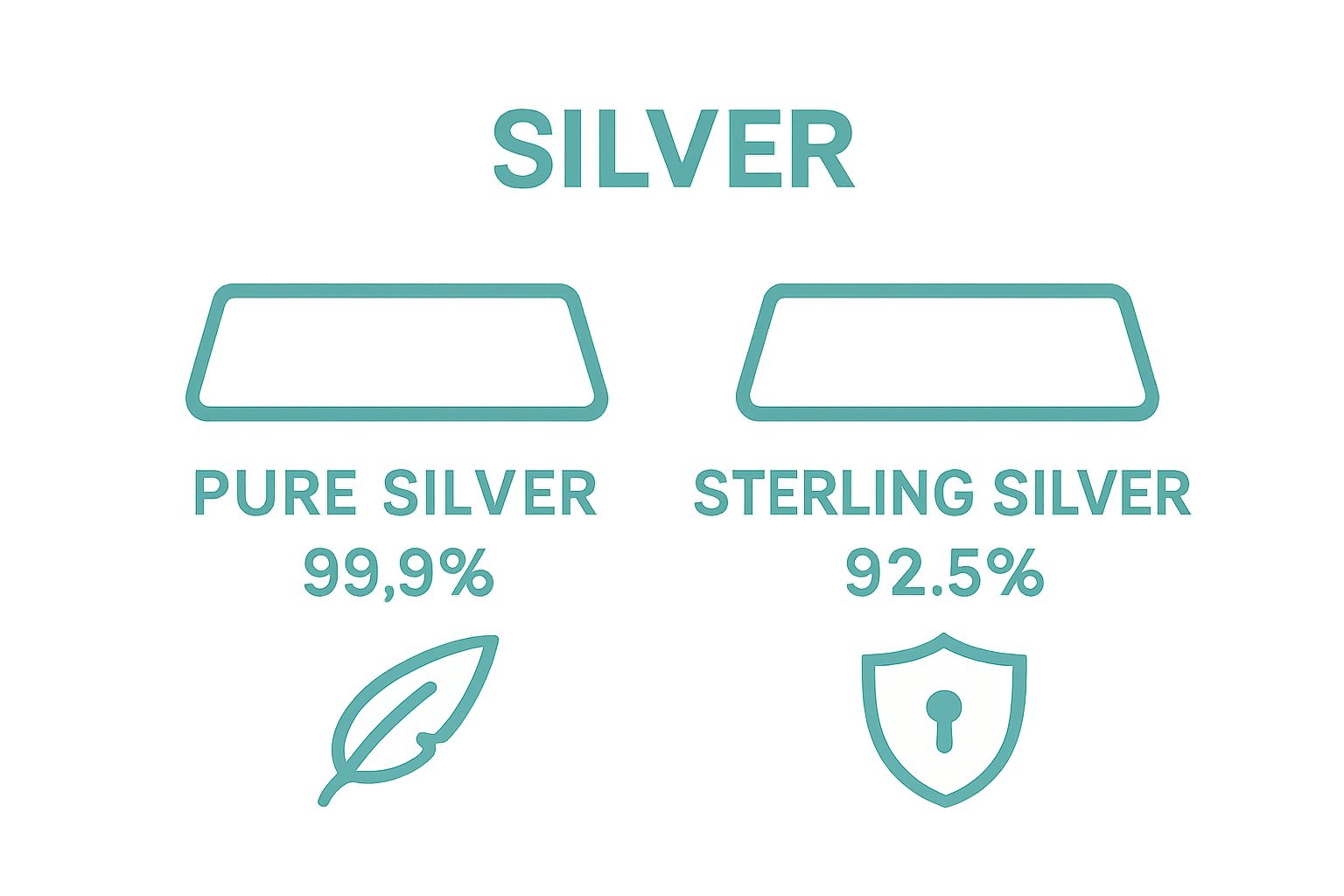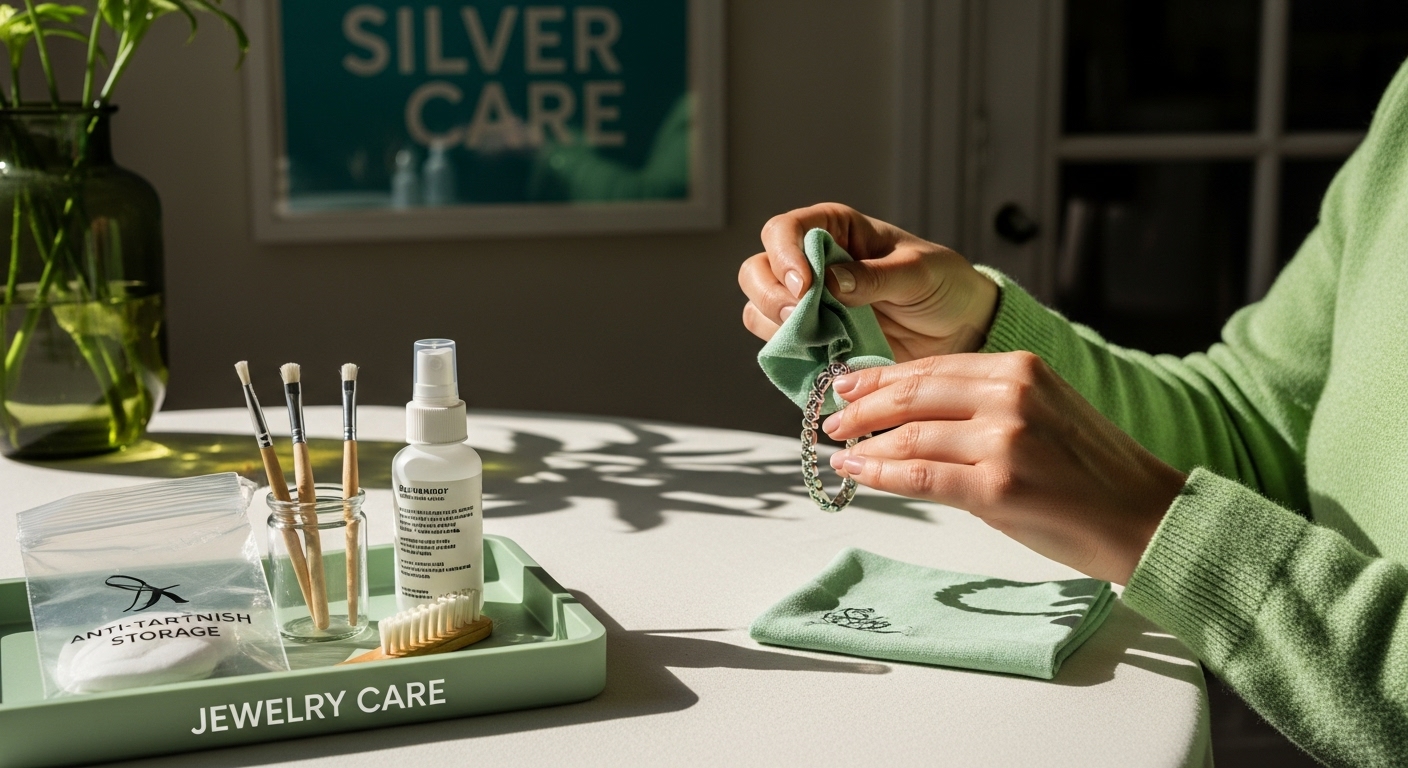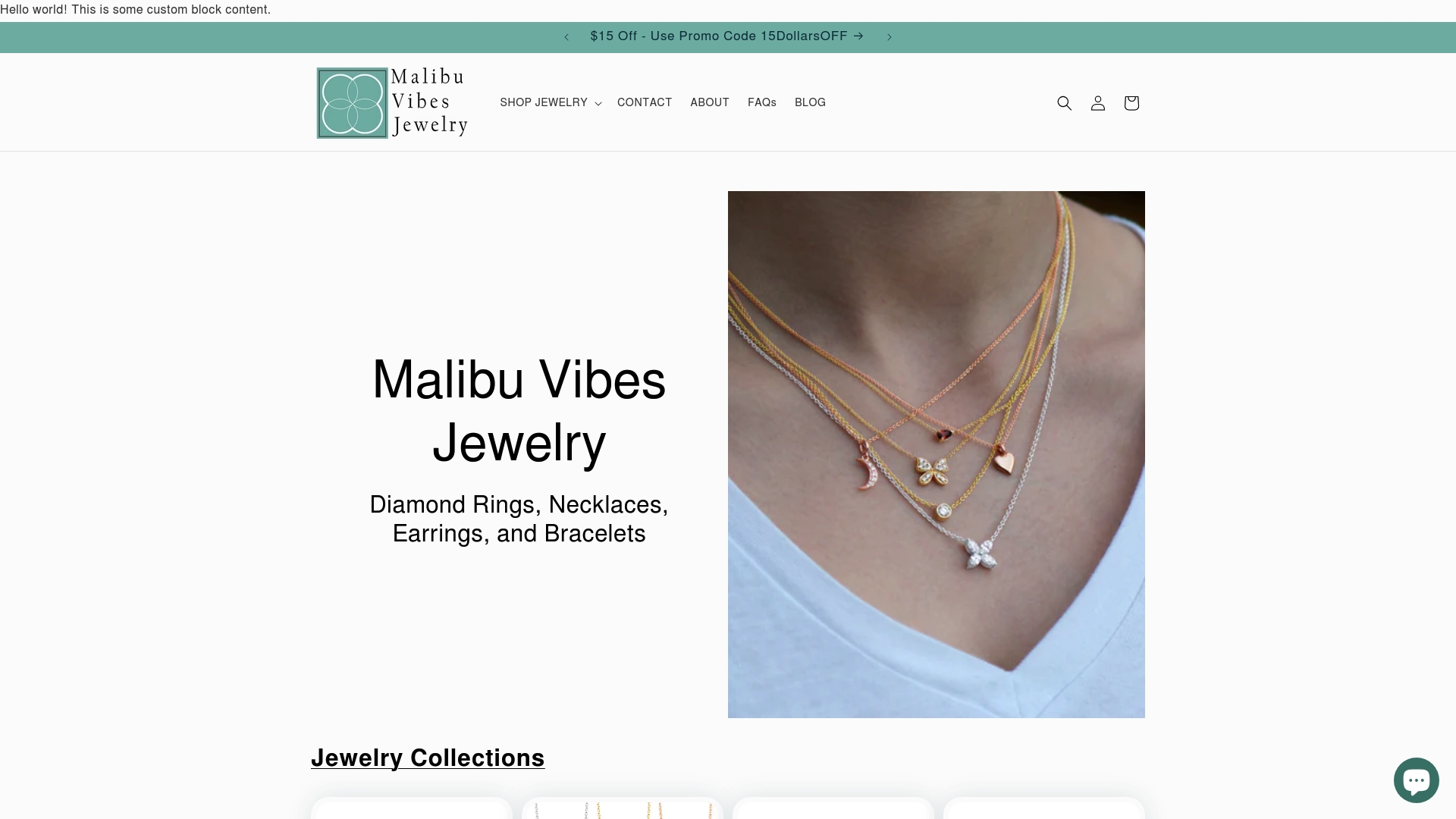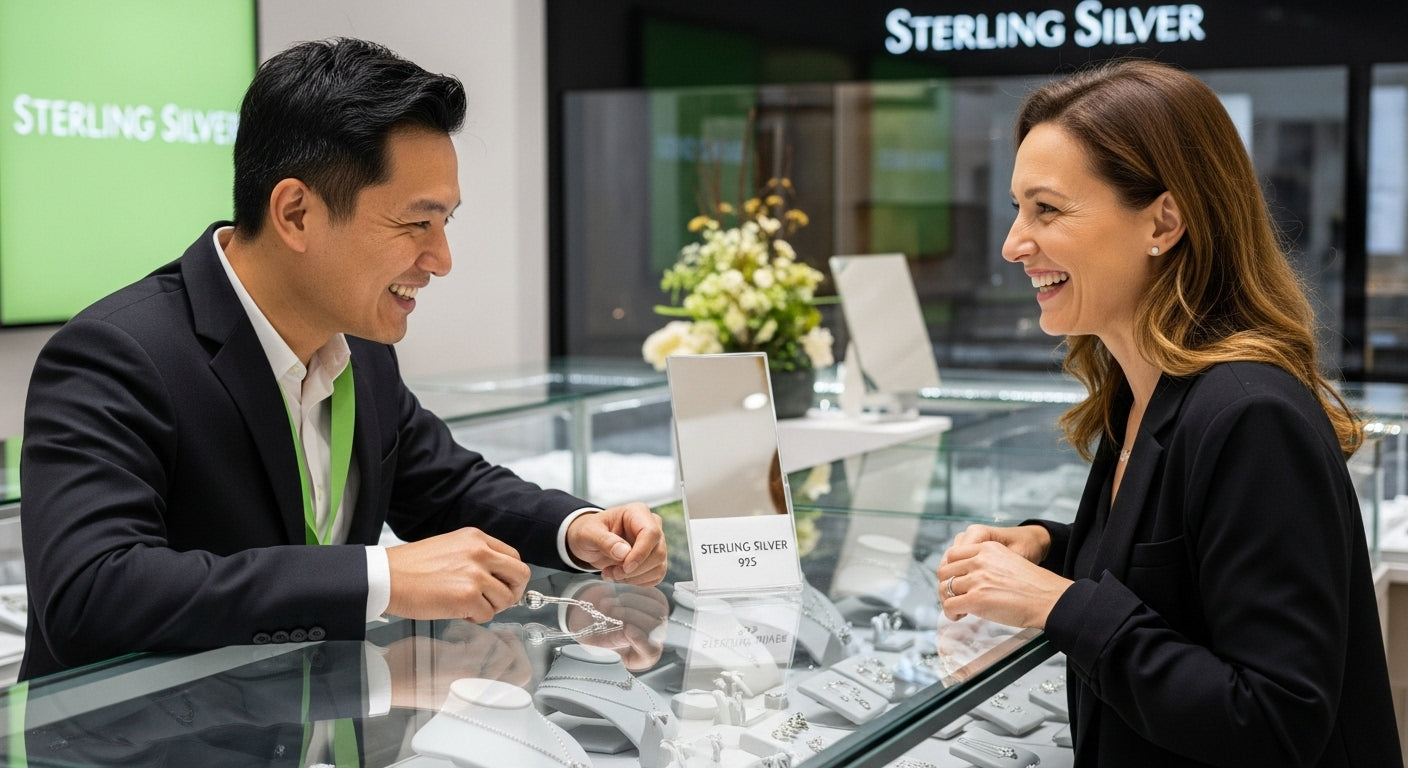Sterling silver 925 is everywhere in fine jewelry, but most people do not realize it is made from exactly 92.5 percent pure silver and 7.5 percent copper. That number may sound technical or trivial. The real surprise is this precise blend is not just for looks, it is engineered to make silver strong enough to wear every day without losing its shine or shape.
Table of Contents
- Defining Sterling Silver 925: Composition And Characteristics
- The Importance Of 925 Silver In Jewelry: Quality And Endurance
- How Sterling Silver Is Made: The Production Process Explained
- Key Differences Between Sterling Silver And Other Silver Types
- Caring For Sterling Silver 925: Maintenance For Longevity
Quick Summary
| Takeaway | Explanation |
|---|---|
| Sterling silver 925 is 92.5% silver and 7.5% copper. | This alloy composition enhances strength, durability, and suitability for intricate designs, making it ideal for jewelry. |
| Look for the ‘925’ stamp for authenticity. | The ‘925’ hallmark indicates the precise silver content, ensuring quality and authenticity in sterling silver jewelry. |
| Sterling silver offers superior durability compared to pure silver. | The addition of copper transforms pure silver, making it more resistant to scratches and deformation, perfect for everyday wear. |
| Proper care prevents tarnish and maintains luster. | Store jewelry in airtight bags and limit exposure to moisture and chemicals to reduce tarnishing and preserve shine. |
| Sterling silver jewelry retains value over time. | High-quality pieces can become cherished heirlooms, making investment in sterling silver jewelry both beautiful and practical. |
Defining Sterling Silver 925: Composition and Characteristics
Sterling silver 925 represents a precise metallic composition that combines scientific precision with artistic craftsmanship. At its core, this alloy consists of 92.5% pure silver and 7.5% copper, creating a material that balances elegance and durability. Learn more about our sterling silver collection.
The Science Behind the Alloy
The specific ratio of silver to copper is not arbitrary but carefully engineered. According to metallurgical research from the Santa Fe Symposium, adding copper serves critical functional purposes. The copper molecules create a stronger molecular structure, enhancing the silver’s inherent softness and improving its mechanical properties.
Key characteristics of sterling silver 925 include:
- Enhanced structural integrity
- Increased resistance to deformation
- Improved durability compared to pure silver
- Greater suitability for intricate jewelry designs
Practical Applications and Verification
In practical terms, sterling silver 925 is identifiable through specific markings. Jewelry pieces will typically bear a “925” stamp, indicating the precise silver content. This hallmark serves as a guarantee of quality and authenticity, allowing consumers to confidently distinguish genuine sterling silver from lower-grade alternatives.
The copper component transforms pure silver from a delicate, easily damaged metal into a robust material perfect for everyday jewelry. Craftsmen appreciate sterling silver 925 for its ability to maintain intricate details while offering superior wear resistance. This makes it an ideal choice for rings, necklaces, bracelets, and other pieces that require both aesthetic beauty and structural strength.
The Importance of 925 Silver in Jewelry: Quality and Endurance
Sterling silver 925 transcends mere aesthetic appeal, representing a pinnacle of metallurgical engineering and jewelry craftsmanship. Its unique composition ensures exceptional durability, making it a preferred material for discerning jewelry enthusiasts. Explore our fine jewelry guide to understand how materials like sterling silver define luxury.
Longevity and Resilience
According to research from the Silver Institute, sterling silver’s carefully balanced alloy composition provides remarkable durability. The addition of copper creates a molecular structure that significantly enhances the metal’s strength, transforming delicate pure silver into a robust material capable of withstanding daily wear.
Key advantages of sterling silver 925 include:
- Resistance to scratching and deformation
- Ability to maintain intricate design details
- Long-term value retention
- Hypoallergenic properties for sensitive skin
Investment and Aesthetic Value
Beyond its physical properties, sterling silver 925 represents a sound investment. Jewelry crafted from this alloy maintains its value over time, with high-quality pieces becoming cherished heirlooms. Professional jewelers appreciate 925 silver for its versatility, allowing complex designs that balance artistic expression with structural integrity.
The hallmark “925” is more than a stamp; it’s a promise of quality. This mark guarantees the precise silver content, offering consumers confidence in their purchase. Whether you’re selecting a delicate necklace, an elegant bracelet, or statement earrings, sterling silver 925 ensures a piece that combines timeless beauty with exceptional durability.
How Sterling Silver is Made: The Production Process Explained
The creation of sterling silver is a sophisticated metallurgical process that transforms raw materials into a refined, durable alloy. Learn more about our fine jewelry making process, which exemplifies the meticulous craftsmanship behind each piece.
Raw Material Selection and Refinement
According to research from the United States Geological Survey, sterling silver production begins with selecting high-purity silver. Manufacturers carefully source silver with minimal impurities, typically from mining operations or recycling processes. The goal is to achieve a base material that meets stringent quality standards for the final 925 alloy.
Key steps in silver preparation include:
- Extracting raw silver from ore
- Refining to remove mineral impurities
- Testing silver purity using specialized laboratory techniques
- Measuring precise silver content before alloying
Precision Alloying and Metallurgical Engineering
The transformation from pure silver to sterling silver requires precise metallurgical expertise. Craftsmen carefully introduce copper into the molten silver, maintaining the exact 92.5% silver and 7.5% copper ratio. This delicate process involves controlled heating and mixing at specific temperatures to ensure uniform molecular distribution.
The copper addition serves multiple critical functions: it increases the metal’s hardness, improves structural integrity, and creates a more workable material for intricate jewelry designs. Professional metalworkers use advanced techniques like induction melting and continuous casting to guarantee consistent quality in every sterling silver production batch.
The table below summarizes the essential steps in the sterling silver production process, highlighting how raw silver is transformed into jewelry-quality alloy.
| Production Stage | Description |
|---|---|
| Raw Material Extraction | Silver is sourced from mining or recycling operations |
| Silver Refinement | Impurities are removed to achieve high-purity silver |
| Purity Testing | Specialized laboratory techniques confirm silver content |
| Precision Alloying | Copper is added, maintaining the 92.5% silver to 7.5% copper ratio |
| Controlled Melting & Mixing | Metals are heated and blended for uniform molecular distribution |
| Continuous Casting/Forming | Molten alloy is formed into bars, sheets, or specific jewelry shapes |
Key Differences Between Sterling Silver and Other Silver Types
Silver exists in multiple forms, each with unique characteristics that distinguish them in the jewelry and metalworking world. Understand the nuances of silver jewelry to make informed purchasing decisions.
Pure Silver vs Sterling Silver
According to research from the Diplomatic Rooms, pure silver is inherently soft and malleable, making it unsuitable for everyday jewelry or functional items. Sterling silver, by contrast, introduces copper to create a more robust material. The key distinctions are profound:

- Pure silver contains 99.9% silver with minimal metallic additions
- Sterling silver contains 92.5% silver and 7.5% copper
- Pure silver is significantly softer and more prone to damage
- Sterling silver offers enhanced durability and structural integrity
Metallic Composition and Performance
The introduction of copper in sterling silver fundamentally transforms the metal’s properties. While pure silver appears more pristine, it lacks the mechanical strength required for intricate jewelry designs. Sterling silver provides jewelers with a material that can withstand daily wear, maintain complex shapes, and resist deformation.
Other silver variations like coin silver (90% silver) or silver-plated items differ substantially from sterling silver. These alternatives often compromise on purity, durability, or overall quality. Professional jewelers and discerning consumers recognize sterling silver 925 as the gold standard for silver jewelry, valuing its perfect balance between aesthetic beauty and practical performance.
To help clarify the key differences between types of silver commonly used in jewelry, the following table compares their composition and properties.
| Silver Type | Silver Content | Other Metals | Key Properties |
|---|---|---|---|
| Pure Silver | 99.9% | Minimal trace | Very soft, easily scratched, not suitable for daily wear |
| Sterling Silver 925 | 92.5% | 7.5% copper | Durable, ideal for jewelry, holds intricate designs |
| Coin Silver | 90% | 10% copper | Less pure than sterling, used historically in coins |
| Silver-Plated | Varies (thin layer) | Base metal core | Not solid silver, less durable, tarnishes/loss of finish |
Caring for Sterling Silver 925: Maintenance for Longevity
Sterling silver requires thoughtful care to preserve its brilliant luster and structural integrity. Learn about our jewelry care recommendations to protect your precious pieces and maintain their timeless beauty.
Understanding Silver Tarnish and Prevention
According to conservation experts at Emory University’s Michael C. Carlos Museum, tarnish is an inevitable chemical reaction caused by exposure to sulfur compounds in the air, moisture, and human skin oils. Sterling silver’s copper content makes it more susceptible to oxidation, which creates the characteristic dark patina.
Key strategies for preventing tarnish include:
- Store sterling silver in airtight, anti-tarnish bags
- Keep jewelry away from humid environments
- Avoid contact with chemicals like perfume, hairspray, and cleaning products
- Use silica gel packets in storage containers to absorb moisture
Cleaning and Restoration Techniques
Professional jewelry maintenance requires gentle, precise techniques. Gentle polishing with a soft, lint-free cloth can remove light tarnish without damaging the silver’s surface. For more thorough cleaning, use specialized silver polishing cloths or mild solutions designed specifically for sterling silver.
Extreme caution is essential when cleaning intricate pieces. Avoid abrasive materials or harsh chemical cleaners that could strip away the silver’s protective layer or damage delicate designs. Regular, gentle maintenance prevents significant tarnish buildup and preserves the jewelry’s original brilliance and structural integrity.

Discover the True Value of Sterling Silver 925 with Malibu Vibes Jewelry
Are you searching for real sterling silver jewelry that delivers both elegance and durability? Many jewelry lovers face the challenge of finding pieces that balance the pure beauty of silver with everyday strength. As highlighted in our article, sterling silver 925 stands out for its distinct composition—92.5 percent silver blended with copper for lasting shine and reliable wear. Authenticity and quality are vital for every piece you choose.

Experience the craftsmanship and integrity that Malibu Vibes Jewelry brings to every sterling silver creation. Choose from our curated Sterling Silver Jewelry Collection or explore the latest arrivals at Malibu Vibes Jewelry. Now is the perfect time to elevate your personal collection with jewelry designed to endure. Find your new favorite accessory today and enjoy enduring luxury with confidence.
Frequently Asked Questions
What is the composition of sterling silver 925?
Sterling silver 925 is an alloy that consists of 92.5% pure silver and 7.5% copper. This specific composition enhances the metal’s strength and durability compared to pure silver.
How can I identify sterling silver 925 jewelry?
You can identify sterling silver 925 jewelry by looking for a hallmark or stamp that indicates ‘925.’ This mark guarantees that the item contains the precise silver content required for sterling silver.
Why is sterling silver 925 more durable than pure silver?
Sterling silver 925 is more durable because the addition of copper creates a stronger molecular structure, enhancing its resistance to deformation and wear. This makes it suitable for everyday use in jewelry.
How should I care for my sterling silver 925 jewelry?
To care for sterling silver 925 jewelry, store it in airtight, anti-tarnish bags, avoid exposure to moisture and chemicals, and clean it regularly with a soft cloth or specialized silver cleaning products to prevent tarnishing.
Recommended
- What is Sterling Silver? Understanding Its Value and Uses – Malibu Vibes Jewelry
- Understanding the Meaning of Sterling Silver Jewelry – Malibu Vibes Jewelry
- What is 14k Gold? Understanding Its Beauty and Value – Malibu Vibes Jewelry
- What is Fine Jewelry? Understanding Luxury and Craftsmanship – Malibu Vibes Jewelry

